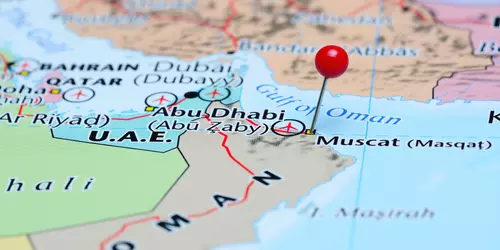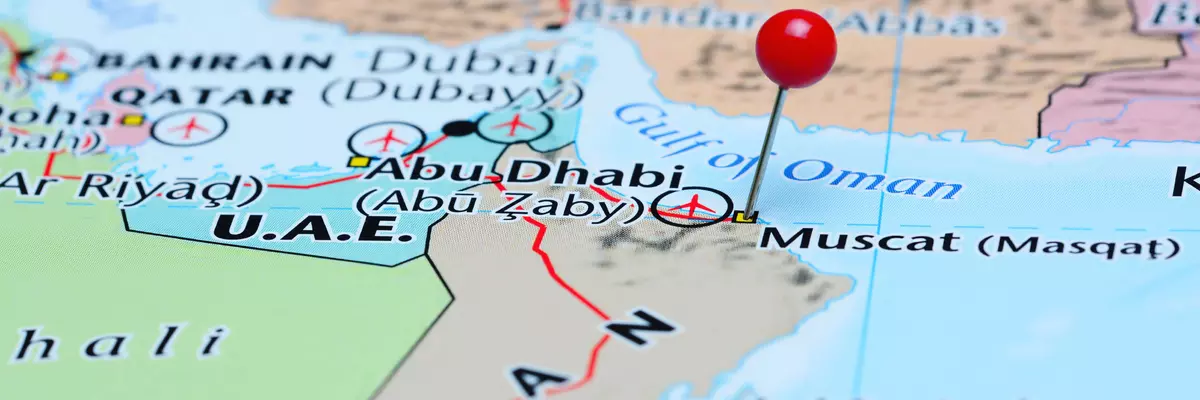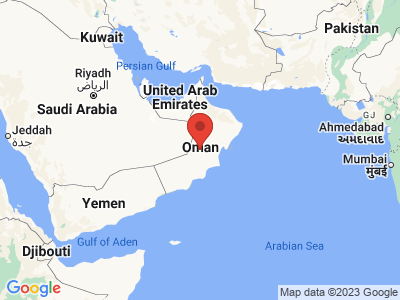Climate Table Oman
Jan | Feb | Mar | Apr | May | Jun | Jul | Aug | Sep | Oct | Nov | Dec | |
|---|---|---|---|---|---|---|---|---|---|---|---|---|
| Max. Temperature | 19° | 21° | 24° | 27° | 33° | 35° | 37° | 36° | 36° | 32° | 27° | 22° |
| Min. Temperature | 14° | 15° | 17° | 21° | 26° | 28° | 29° | 30° | 27° | 24° | 21° | 16° |
| Sun Hours | 8 | 8 | 8 | 10 | 12 | 12 | 10 | 10 | 10 | 10 | 9 | 8 |
| Water Temperature | 19° | 18° | 23° | 27° | 27° | 27° | 29° | 32° | 27° | 27° | 25° | 24° |
| Rain Days | 1 | 2 | 1 | 2 | 0 | 0 | 0 | 0 | 0 | 0 | 1 | 1 |
The climate year of Oman
Oman is primarily seen as a hot, dry desert country. However, depending on the region and altitude, the climate ranges from temperate to tropical.
In the northeast of the country is the Hajar Mountains, where it even snows at times at altitudes up to 3,000 meters. Subtropical conditions prevail in the coastal regions in the north on the Gulf of Oman and in the interior in the desert areas. The south, bordering the Arabian Sea, has a tropical monsoon climate with a rainy season.
General information about Oman
Oman is a true paradise for both nature and culture lovers. In the capital Muscat, in addition to the well-preserved old town, the magnificent Sultan Qaboos Grand Mosque, one of the largest mosques in the world, is particularly impressive. The cities of Nizwa and Bahla in the north of the country are also worth a visit.
Grandiose views are guaranteed by the many wadis and the mountainous region of Jebel Akhdar. Especially impressive is the Wadi Nakhar, which is also called the Grand Canyon of Oman. A beautiful, palm-fringed oasis, which also invites you to swim, can be found in Wadi Bani Khalid. Fantastic beaches along the 1,700-kilometer coastline offer relaxation and water sports activities.
The sultanate also has a share in the world's largest sand desert, the Rub-al-Khali Desert. Sand dunes here reach heights of over 200 meters. Also worth seeing is the Ramlat al Wahiba Desert, which extends to the coast of the Indian Ocean.
Tourism Oman
January starts off relatively cool in the north. In the capital Muscat, temperatures regularly settle at around 20 degrees, but humidity is high year-round. In the Hajar Mountains, January and February are winter in the Central European sense. The thermometer often even shows values below freezing point and it also snows. The southwestern Hajar Mountains, which find their foothills in the desert regions, offer a correspondingly warmer climate. In the south of the country or on the island of Masirah, it is hot even in the winter months.
In spring, temperatures also rise in northern Oman, although the months of March and April remain bearable and are suitable for travel. They also have less precipitation than the winter months.
In conjunction with the trade winds, the tropical south is hit by monsoon-like rains starting in June. These can last until September. Cyclones bring humid and windy weather. Humidity is very high.
Starting from the northern Oman Mountains, a hot downdraft wind called Gharbi blows, which favors the high temperatures in the north as well. It is interesting to note that temperatures often peak in the morning and drop somewhat by midday.
The further inland into the desert regions, the hotter and drier it gets. Temperatures of over 50 degrees are not uncommon. The fluctuations between day and night are enormous, as is usual in deserts.
The summer months in the Hajar Mountains are warm and humid, although it also cools down considerably at night there.
From September on, the sunshine hours increase again, even in the south. The rainy season is now over. In the other regions, the climate differs only slightly from the previous months. It is not until November that temperatures start to drop at higher altitudes and in the north of the country.


